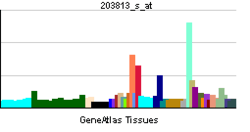SLIT3
| View/Edit Human | View/Edit Mouse |
Slit homolog 3 protein is a protein that in humans is encoded by the SLIT3 gene.[3][4][5]
References
- ↑ "Human PubMed Reference:".
- ↑ "Mouse PubMed Reference:".
- ↑ Nakayama M; Nakajima D; Nagase T; Nomura N; Seki N; Ohara O (Sep 1998). "Identification of high-molecular-weight proteins with multiple EGF-like motifs by motif-trap screening". Genomics. 51 (1): 27–34. doi:10.1006/geno.1998.5341. PMID 9693030.
- ↑ Itoh A; Miyabayashi T; Ohno M; Sakano S (Feb 1999). "Cloning and expressions of three mammalian homologues of Drosophila slit suggest possible roles for Slit in the formation and maintenance of the nervous system". Brain Res Mol Brain Res. 62 (2): 175–186. doi:10.1016/S0169-328X(98)00224-1. PMID 9813312.
- ↑ "Entrez Gene: SLIT3 slit homolog 3 (Drosophila)".
Further reading
- Holmes GP, Negus K, Burridge L, et al. (1999). "Distinct but overlapping expression patterns of two vertebrate slit homologs implies functional roles in CNS development and organogenesis". Mech. Dev. 79 (1–2): 57–72. doi:10.1016/S0925-4773(98)00174-9. PMID 10349621.
- Little MH, Wilkinson L, Brown DL, et al. (2001). "Dual trafficking of Slit3 to mitochondria and cell surface demonstrates novel localization for Slit protein". Am. J. Physiol., Cell Physiol. 281 (2): C486–95. PMID 11443047.
- Marillat V, Cases O, Nguyen-Ba-Charvet KT, et al. (2002). "Spatiotemporal expression patterns of slit and robo genes in the rat brain". J. Comp. Neurol. 442 (2): 130–155. doi:10.1002/cne.10068. PMID 11754167. replacement character in
|last6=at position 3 (help) - Little M, Rumballe B, Georgas K, et al. (2003). "Conserved modularity and potential for alternate splicing in mouse and human Slit genes". Int. J. Dev. Biol. 46 (4): 385–91. PMID 12141424.
- Jiang LQ; Wen SJ; Wang HY; Chen LY (2003). "Screening the proteins that interact with calpain in a human heart cDNA library using a yeast two-hybrid system". Hypertens. Res. 25 (4): 647–652. doi:10.1291/hypres.25.647. PMID 12358155.
- Strausberg RL, Feingold EA, Grouse LH, et al. (2003). "Generation and initial analysis of more than 15,000 full-length human and mouse cDNA sequences". Proc. Natl. Acad. Sci. U.S.A. 99 (26): 16899–16903. doi:10.1073/pnas.242603899. PMC 139241
 . PMID 12477932.
. PMID 12477932. - Clark HF, Gurney AL, Abaya E, et al. (2003). "The secreted protein discovery initiative (SPDI), a large-scale effort to identify novel human secreted and transmembrane proteins: a bioinformatics assessment". Genome Res. 13 (10): 2265–2270. doi:10.1101/gr.1293003. PMC 403697
 . PMID 12975309.
. PMID 12975309. - Ota T, Suzuki Y, Nishikawa T, et al. (2004). "Complete sequencing and characterization of 21,243 full-length human cDNAs". Nat. Genet. 36 (1): 40–45. doi:10.1038/ng1285. PMID 14702039.
- Shi Y, Zhao X, Yu L, et al. (2004). "Genetic structure adds power to detect schizophrenia susceptibility at SLIT3 in the Chinese Han population". Genome Res. 14 (7): 1345–1349. doi:10.1101/gr.1758204. PMC 442150
 . PMID 15231749.
. PMID 15231749. - Hammond R, Vivancos V, Naeem A, et al. (2005). "Slit-mediated repulsion is a key regulator of motor axon pathfinding in the hindbrain". Development. 132 (20): 4483–4495. doi:10.1242/dev.02038. PMID 16162649.
- Lin L; Isacson O (2006). "Axonal growth regulation of fetal and embryonic stem cell-derived dopaminergic neurons by Netrin-1 and Slits". Stem Cells. 24 (11): 2504–2513. doi:10.1634/stemcells.2006-0119. PMC 2613222
 . PMID 16840550.
. PMID 16840550.
This article is issued from Wikipedia - version of the 11/29/2016. The text is available under the Creative Commons Attribution/Share Alike but additional terms may apply for the media files.
